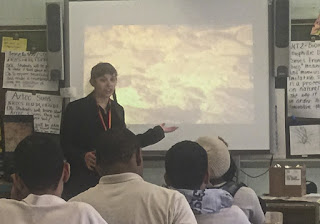At the end of the school year, in June, the students participated in a culminating field trip to the Turtle Back Zoo in West Orange, NJ. In addition to Principal Van Lieu and their teachers, they were accompanied by Art Professor in Residence Simone Sandler, Math Professor in Residence Paul Odenwelder, Leader in Residence Robert Reid, and Geraldine R. Dodge Grant Coordinator Dina Scacchetti.
During the day-long tour of the zoo, they saw many of the animals they had studied. While animals such as wolves had to be kept safely behind unbreakable glass, birds such as peacocks roamed free.
Students also had the opportunity to feed the birds in the aviary.
Upon their return, the students produced reports and collages about their experiences that included “foldables”, thus continuing the integration of art and science.



































